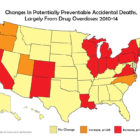A Troubling Trend: Binge Drinking Is Up Among Older Women
|
In the Netflix series “Grace and Frankie,” Grace, a 70-something businesswoman played by Jane Fonda, is often shown knocking back drinks. In fact, a wine glass is as much a part of the character’s wardrobe as are tailored pants and jaunty neck scarves. For a time, a California wine company sold “MommyJuice,” and last month, Fox News shared a story with the headline “7 Signs You’re Hitting the Mommy Juice Too Hard.”
Who knew womanhood was a condition in need of alcohol—lots of it. Ironically, when people talk about binge drinking, the conversation most often turns to college students—or to young men. But there’s a large group of people who are excessively drinking under the radar: the grandmothers of those college students.

